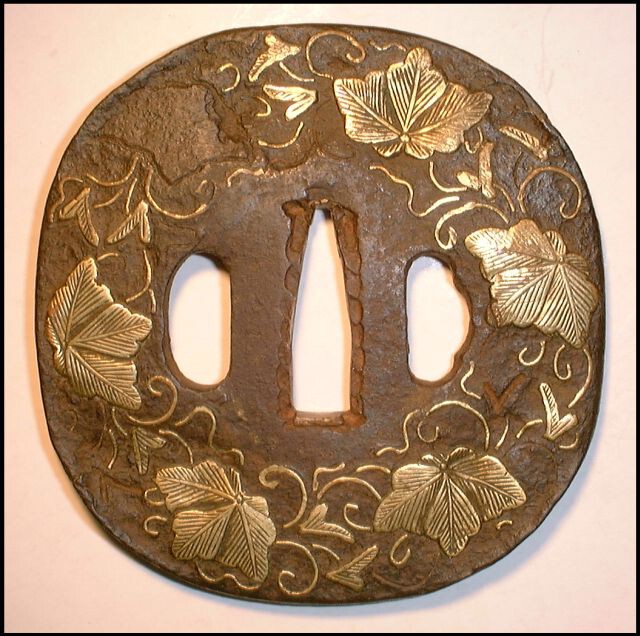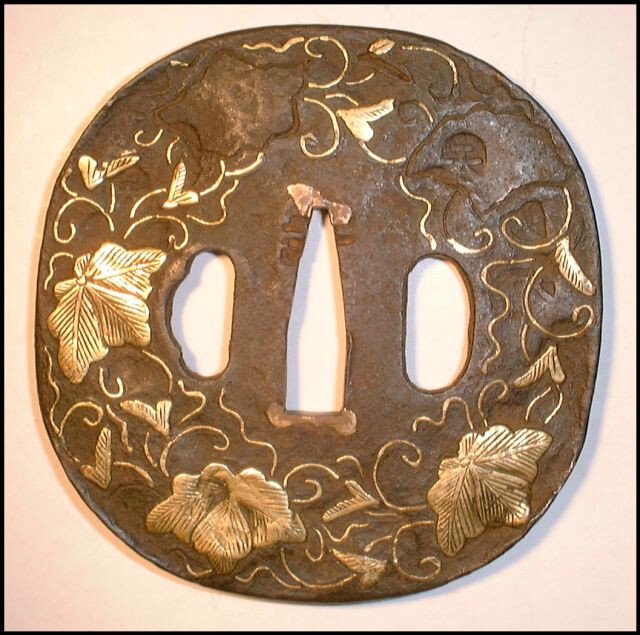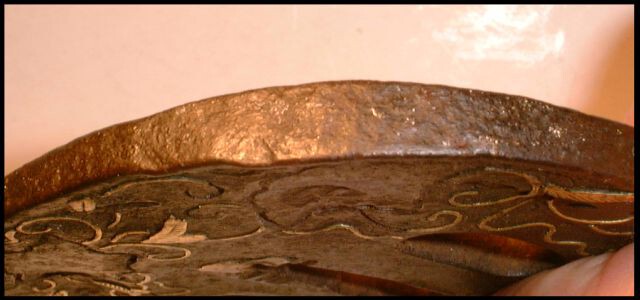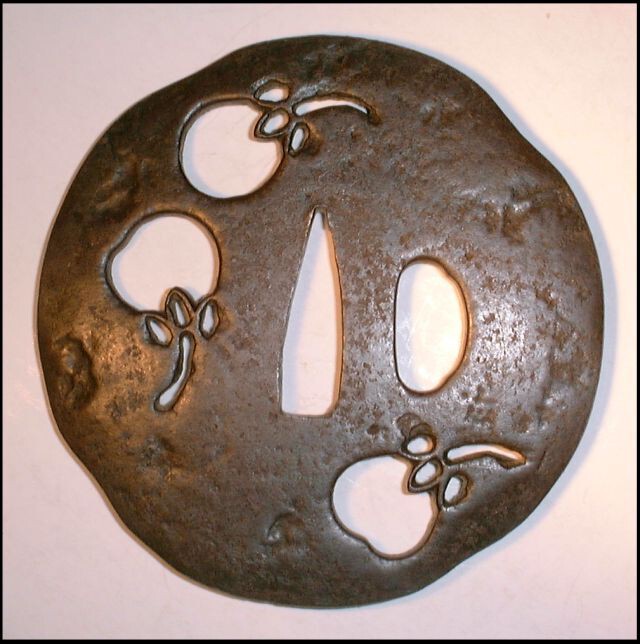-
Posts
815 -
Joined
-
Last visited
-
Days Won
1
Content Type
Profiles
Forums
Events
Store
Downloads
Gallery
Everything posted by docliss
-
Rich’s suggestion of an Aizu Shōami provenance for Dave’s tsuba is an interesting one, and there is certainly a strong Nara influence in the later work of that school. But I cannot agree with him for several reasons: • Aizu Shōami tsuba are commonly maru-gata or tate-maru-gata; other shapes are rare. • The hitsu-ana of this group are wide, in the general Shōami style. • Mikagi-ji is the most common finish for tsuba of this group, although some are tsuchime-ji, as is Dave’s. • This tsuba is mumei, while the later work of the Aizu Shōami group is frequently signed AIZU SHOAMI. I think that I will stick with the Nara provenance. John L.
-
Dave, I apologise for my unexplained abbreviation. By C19 I meant, simply, 19th century work. J.
-
Dear Dave The distinction between Nara and Mito work is a difficult one, the style of the latter being derived from that of the Nara masters, although they tended to favour rather higher relief in their work. Personally I would favour a Nara (not Ko-Nara) label for your tsuba. The nature of the iron plate and the rather subdued style of the iroye work favour this attribution; Mito work is commonly on a polished plate of lighter patination, and has more ‘brightness’ than is displayed by your example. So, perhaps C19, Nara work, but I would be interested too hear some other opinions. John L.
-
Here is example of an early tenpō tsuba, 7.8 cm – 7.6 cm, with the later addition of a gold, suemon-zōgan depiction of ivy (tsuta) leaves and tendrils. There is a raised, flattened, hammered mimi, a small kōgai-hitsu, and what appear to be brass sekigane in the well-used nakago-hitsu. The inlay covers much of the kokuin, but some of this has been lost, clearly revealing a ‘ten’ kanji at 2 o’clock on the ura surface. Search as I may, I can detect no indications of folding. I am puzzled by the choice by tsubakō of tenpō plates for later decoration; surely such work would have been simpler on plain, undecorated plates? John L.
-
Tim’s tsuba is signed SUIJO ADZUMA OKABE MASANOBU, and is presumably the work of that artist (H 04308.0), working in Mito ca 1800, since such a signature is unlikely to be gimei. I agree that it shows no signs of having been mounted, but was probably intended for use at the time of its manufacture. Personally, I find it rather vulgar and with little to recommend it. John L.
-
Thank you, Ted, for those images. I am fascinated to see them, having previously doubted if such things as Namban menuki really existed. One now has to presume that their present scarcity is due to their degradation by rust rather than their simply not having been practicable to create. Kind regards, John L.
-
Dear John In an earlier posting in this thread, Ted Tenold intimated that he has access to some images of Namban menuki, which has kept me in high hope of seeing them. But, like you, I have never yet seen any evidence that such beasts exist. John L.
-
Dear Steve Thank you for posting the charming image of the menuki. It is, of course, typical of Hirado Kunishige work and the mei of Hirado (平戸), together with the use of random Western characters and of the dragon motif, would seem to confirm this. I do not personally consider such work to fall within the Namban group, however, and would still like to see some openwork menuki, undercut and rendered in iron, that fulfil my own conception of Namban work. John L.
-
What comments on a possible, alternative, Kinai attribution for Steeve's second tsuba? John L.
-
Reinhard has initiated an interesting thread on the subject of Hamamono kodōgu but, as has happened before, it has become mired by the attempts of members — many of them both erudite and literate — to explain their personal interpretation of Japanese aesthetics. Surely the subject is much simpler than that …. If we accept a definition of Hamamono kodōgu as ‘work created in Japan for the export market’, this will include a wide range of fittings that vary greatly both in quality and style. At one end of this spectrum we have the tatty work produced for sale to tourists on the docs at Yokohama while, at the other end are Meiji works, comissioned by wealthy Western collectors from such artists as Namekawa Sadakatsu, Unno Shōmin and Unno Moritoshi. Clearly we would be in error to assume that all work that demonstrates a Western influence qualifies as Hamamono work. The Japanese market experienced fashions in style just as do all commerce-led economies. The enormous popularity of the Namban style in the late 18th and early 19th centuries, and the Art Deco influence demonstrated in the work of Itō Masayoshi (1744-1796) are both clear examples of foreign influences not intended for export. Thus only two groups of tsuba may be confidently labelled as Hamamono — those that were commissioned by Western collectors and have a clear provenance; and those rare pieces that acknowledge their commission on the mei — the remainder remain a matter of opinion. In closing, it is interesting that there has been no mention in this thread of the Boston Museum of Fine Arts publication, Lethal Elegance, which contains many fine examples of such work, commissioned by William Sturgis Bigelow and Charles Goddard Weld in the late 1800s. Regards, John L.
-
Keith G states that ‘we can say without fear of contradiction that the so called “namban” style of tsuba and tosogu are almost definately (sic) the product of western influence.’ Oh dear — I have always believed them to be the product of Chinese rather than of Western influence. Please correct me if I am wrong. John L.
-
Thank you - I see it now! John L.
-
I appear to have developed a ‘block’ over the translation of these tsuba kanji: 古 金 工. Can anybody help me, please? With grateful thanks, John L.
-
In spite of the tendency for soft-metal tsuba to readily undergo surface changes in the area of the seppa after mounting, I can see no indication on either the dai or the shō tsuba that they were ever mounted on a sword. And in reply to George’s query - as John has already stated – yes, and sekigane also. John L.
-
Dear Lorenzo, it is very difficult to be certain of the original form of Namban koshirae. Without a secure provenance there is no certainty that those in existence are ubu, and Namban koshirae were not deposited in reputable Japanese collections. However, those that I have seen have all been conventionally mounted, with same tsuka, and I see no reason to doubt that this was the norm. Regards, John L.
-
I am grateful to Chris for posting the images of the Namban fuchi-gashira and kozuka. There are a number of possible reasons for the extreme scarcity of these small fittings. The production of such delicate work must have been technically difficult; such small fittings do not adequately display the skill of this work; and the undercutting on these would have created a large surface area relative to their size and made them very prone to destruction by rusting. Neither is the character of fittings associated with Namban tsuba known, and these may generally have been either plain iron or low relief karakusa-and-dragon designs. The problem of the adequate display of the undercutting was sometimes resolved by backing such fittings with gold foil. Namban menuki I have never seen, always assuming them either to have been destroyed by rust, or to have consisted of plain iron ‘washers’. PLEASE post some images of these for me. John L.
-
While readily bowing to Ford’s expertise regarding the katakiri techniques displayed by this tsuba, I must express my personal reservations about its overall quality. The placement of the image within the confines of the plate has compromised the depiction of the fore-legs and of the hind quarters, both of which give the impression of having been ‘squeezed’ into the available space. Is this a copy of the third horse from the left in the second Jōchin image posted by John, I wonder. I await, with interest, further postings by Ford on this thread, but tend in the meantime to favour labelling this as a modern repro. John L.
-
With my grateful thanks for your input, I have re-labelled this tsuba as Saotome work of the Momoyama period. John L.
-
Dear Robert, I believe that Haynes does in fact list two artists who signed BISHU (NO)JU MASAYOSHI. The first, Ichiguchi Masayoshi (H 04789.0), used the kanji 正吉 and the second, Fukui Masayoshi (H 04866.0), used 政吉. But, as Pete Klein suggests, we really need more detail before we can hope to progress any further. John L.
-
-
I am reviewing the attributions of some of my tsuba, and would welcome any suggestions concerning this mumei one. Rendered in a very darkly patinated iron, it is ‘irregularly round’ in outline, measuring 8.4 cm – 8.3 cm, and is lenticular in cross section, measuring 0.25 cm at the seppa-dai and less than 0.2 cm at the mimi. The edge is slightly rounded; there are very delicate copper sekigane in the nagako-hitsu; and it has a single, broad kōgai-hitsu. On the tsuchimi-ji plate are depicted three aubergines in negative silhouette. The tsuba is ex the Edgar Jepson collection, dispersed in 1938. In spite of the surprisingly unworn state of the nakago-hitsu, it clearly has considerable age, and I had previously labelled it as C17 Saotome work. With thanks in advance for your comments, John L.
-

What is this? Found it in dresser draw in wooden box>
docliss replied to goinlower6969's topic in Tosogu
This kozuka is signed YASUYUKI, and would appear to be by a Kyoto artist (H 11357.0), working ca 1800. John L. -
Is James’ illustration an example of what is described in the books as an ‘Iri Kinai’ mei, with the third and fourth strokes of the ‘nai’ kanji reversed? This is, I believe, a characteristic of the Takahashi godai and nanadai. John L.
-
Are we looking at the omote or the ura surface of this beautiful tsuba, I wonder. The kōban-shaped seppa-dai; the solid, round mimi; and the dark patination, reminiscent of Chōshū work, are all typical of the later, Takahashi family artists. But I would expect it to be signed ura-mei. I, personally, do not have any problem with the very discrete, gold ten-zōgan decoration. I await further comments with interest. John L.
-
So, should what is generally referred to in the literature as ‘kebori’ now rather be called ‘line engraving’; and is there a Japanese term to specifically describe such a technique? ‘Giri-bori’ is clearly not specific enough in this respect. David only has only to refer to the work of Gotō Ichijō and his students to see superb katakiri-bori in an iron medium. John L.








